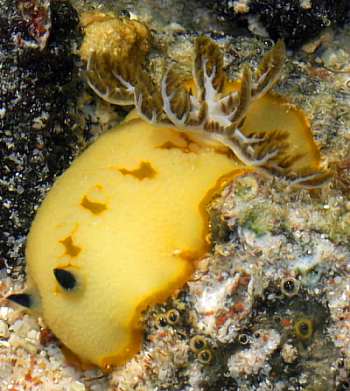
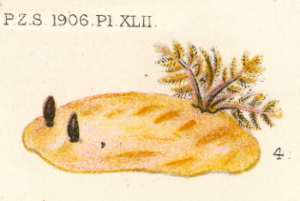
Taringa caudata
(Farran, 1905)
Order: NUDIBRANCHIA
Suborder: DORIDINA
Superfamily: EUDORIDOIDEA
Family: Discodorididae
DISTRIBUTION
Known only from the western Indian Ocean [records from Ceylon, Madagascar, Tanzania, Yemen.]
PHOTO
Upper: Socotra island, Yemen. Gulf of Aden. Depth: 1-2 metres. 05 January 2006. Intertidal. Photographer: Pashkov. Lower: Kelaart's original illustration of Doris luteola, first published by Eliot (1906, Pl 42, fig. 4).
There are raised rhinophore pockets, and the mantle is covered in small rounded tubercles. The gills are proportionally very large and elongate, consisting of long bipinnate branches and very sparse gill lamellae - similar to the shape of many species of Halgerda. Few specimens of this species have been reported. It grows to at least 25 mm in length.
-
Eliot, C.N.E. 1906. On the nudibranchs of southern India and Ceylon, with special reference to the drawings by Kelaart and the collections belonging to Alder and Hancock preserved in the Hancock Museum at Newcastle-on-Tyne. Proceedings of the Zoological Society of London, for 1906: 636-691.
-
Farran, G.P. 1905. Report on the opisthobranchiate Mollusca collected by Professor Herdman, at Ceylon, in 1902. Pp. 329-364 in: Report to the government of Ceylon on the pearl oyster fisheries of the Gulf of Manaar 3, Suppl. Rept. No. 21 (W.A. Herdman, ed.). Royal Society, London.
-
Gosliner, T.M. & Behrens, D.W. (1998) Two new discodorid nudibranchs from the western Pacific with a redescription of Doris luteola Kelaart, 1858. Proceedings of the California Academy of Sciences, 50(11), 279-293.
-
Schroedl, M., 2003 (Feb 3) Homonomy of Doris luteola Kelaart, 1858. [Message in] Sea Slug Forum. Australian Museum, Sydney. Available from http://www.seaslugforum.net/find/9092
Rudman, W.B., 2006 (January 24) Taringa caudata (Farran, 1905). [In] Sea Slug Forum. Australian Museum, Sydney. Available from http://www.seaslugforum.net/find/taricaud
Related messages
Taringa caudata from Reunion Island
January 29, 2009
From: Hugues Flodrops
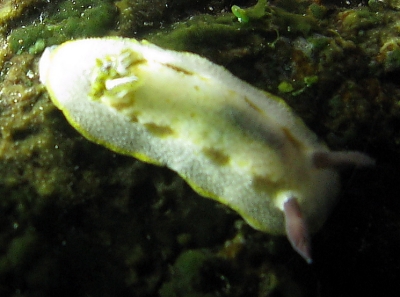
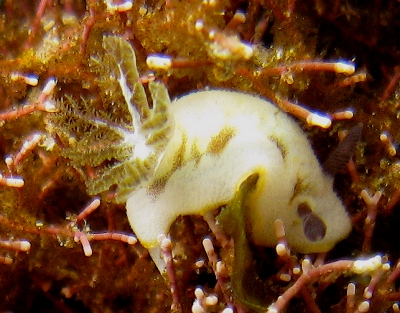
Concerning message #19892:
Dear Bill,
Here are some pictures of the first Taringa caudata from Reunion Island. It was identified by Philibert Bidgrain. The gills branches are white and rhinophores seems to be dark-purple, probably because I used a high quality torche (efficiency 150 watts and 18 leds) with a very white light. I hope it's interesting for the Forum and it's always the same part of Indian Ocean.
Locality: Etang-Salé "Rocky Coast", 1 metre, Reunion Island, Indian Ocean, 16 december 2008, Midnight. Length: 25 mm . Photographer: Hugues Flodrops.
Best regards.
Hugues.
hugues.flodrops@wanadoo.fr
Flodrops,H., 2009 (Jan 29) Taringa caudata from Reunion Island. [Message in] Sea Slug Forum. Australian Museum, Sydney. Available from http://www.seaslugforum.net/find/22183
Thanks Hugues,
It's great to get another record of this easily recognisable - but apparently uncommon species.
Best wishes,
Bill Rudman
Taringa caudata from Oman
July 6, 2007
From: Michel Claereboudt
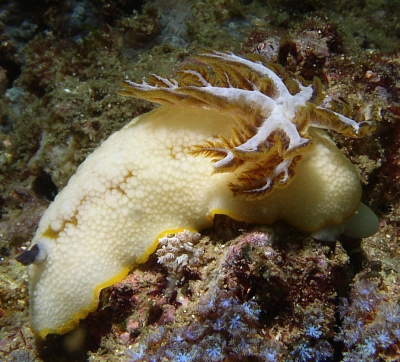
Concerning message #15595:
I observed the same species (I believe) near Muscat in Oman. Which extend considerably the range of the "beast". Although I dive regularly and observe small organisms, I only came across this particular species once. On that day, at that location, they were relatively abundant. Nothing since ....
Locality: Bandar Al-Khayran, 5 m, Oman, Gulf of Oman, 14 feb 2004, on or near coral.. Length: 3.5 cm. Photographer: Michel Claereboudt.
Michel Claereboudt
michelc@squ.edu.om


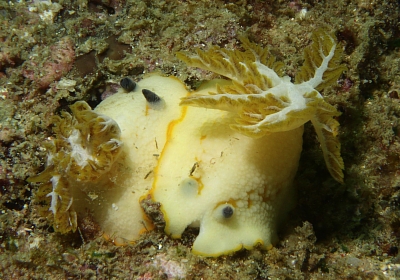
Dear Michel,
This is certainly Taringa caudata. We have very few records of this species from anywhere so its a valuable new record. From the records we have it seems to be restricted to the western half of the Indian Ocean. Since we know so little about it I have added a couple of close-ups to show the mantle tubercles, the rhinophore and the gills.
Best wishes,
Bill Rudman
Re: Can you help Identify this Nudibranch?
January 25, 2006
From: Dave Behrens
Concerning message #15595:
Hi Bill:
I believe this is Taringa luteola. See - http://slugsite.us/bow/nudwk139.htm.
-
Gosliner, T.M. & Behrens, D.W. (1998) Two new discodorid nudibranchs from the western Pacific with a redescription of Doris luteola Kelaart, 1858. Proceedings of the California Academy of Sciences, 50(11), 279-293.
Dave Behrens
dwbehrens@comcast.net
Behrens, D.W., 2006 (Jan 25) Re: Can you help Identify this Nudibranch?. [Message in] Sea Slug Forum. Australian Museum, Sydney. Available from http://www.seaslugforum.net/find/15625Thanks Dave,
Funny what you find on the Forum. After receiving your message I did a quick search to see if Doris luteola was mentioned anywhere and found Michael Schroedl's message [#9092] showing that Doris luteola Kelaart, 1858 was preoccupied by Doris luteola Couthouy in Gould, 1852 and proposing the first available name is Thordisa caudata Farran, 1905. I will prepare a new Fact Sheet for Taringa caudata [= Taringa luteola (Kelaart, 1856)].
Best wishes,
Bill Rudman
Can you help Identify this Nudibranch?
January 21, 2006
From: Lev Sidorov
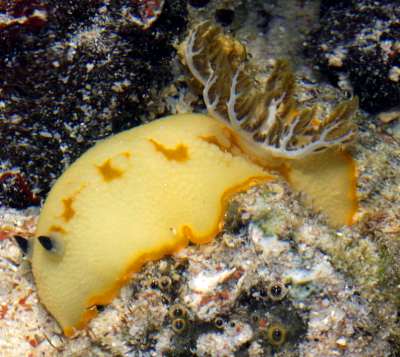
Can you help identify this Nudibranch? This images were made on the reefs of Socotra.
Locality: Socotra island, Yemen. Gulf of Aden. Depth: 1-2 metres. 05 January 2006. Intertidal. Photographer: Pashkov
Best regards,
Lev Sidorov.
sidorov@vniro.ru
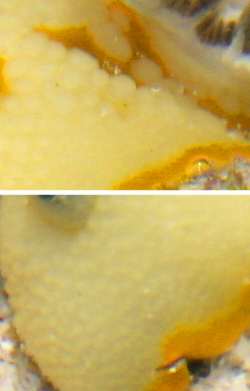

Dear Lev,
This is quite a spectacular dorid. I have a feeling I have seen it before but let us see if someone can help with an identification
Best wishes,
Bill Rudman
Homonomy of Doris luteola Kelaart, 1858
February 3, 2003
From: Michael Schroedl
Dear Bill,
I'd like to contribute the following matter for discussion.
All the best,
Michael Schroedl
Doris luteola Kelaart, 1858, a junior homonym of Doris luteola Couthouy in Gould, 1852
The nudibranch Doris luteola Kelaart, 1858 from the western Indian Ocean, currently placed into the genus Taringa (see Gosliner & Behrens, 1998), is a primary homonym of the Chilean Doris luteola Couthouy in Gould, 1852 (see Gould, 1852). Even though the latter species was considered to be a dubious species by Marcus (1959) and regarded to be not appropriate for reidentification (i.e. a nomen dubium) in a recent revision (Schrödl, 2000), Doris luteola Couthouy in Gould, 1852 was mentioned in several taxonomic lists e.g. by Carcelles (1950) and Carcelles & Williamson (1951; misspelled as Doris lucteola Gould, 1852), and Valdovinos (1995; as Doris luteola Gould, 1852). Thus, the junior name Doris luteola Kelaart, 1858 must be rejected. According to Article 60.2 of the Code (I.C.Z.N., 1999), it is proposed to replace Doris luteola Kelaart, 1858 by its junior synonym Thordisa caudata Farran, 1905 (see Farran, 1905; for synonymization see Eliot, 1906; Gosliner & Behrens, 1998).
References:
• GOSLINER,T.M. & D.W. BEHRENS. 1998. Two new discodorid nudibranchs from the western Pacific with a redescription of Doris luteola Kelaart, 1858. Proceedings of the California Academy of Sciences, 50: 279-293.
• CARCELLES, A.R. 1950. Catálogo de los moluscos marinos de la Patagonia. Anales Museo de Nahuel Huapi, 2: 41-99, pls.1-6.
• CARCELLES, A.R. & S.I. WILLIAMSON. 1951. Catálogo de los moluscos marinos de la Provincia Magallánica. Revista del Instituto Nacional de Investigación de Ciencias Naturales, (Ci. Zool.) Buenos Aires 2: 225-383.
• ELIOT, C.N.E. 1906. On the nudibranchs of southern India and Ceylon, with special reference to the drawings by Kelaart and the collections belonging to Alder and Hancock preserved in the Hancock Museum at Newcastle-on-Tyne. Proceedings of the Zoological Society of London, for 1906: 636-691.
• FARRAN, G.P. 1905. Report on the opisthobranchiate Mollusca collected by Professor Herdman, at Ceylon, in 1902. Pp. 329-364 in: Report to the government of Ceylon on the pearl oyster fisheries of the Gulf of Manaar 3, Suppl. Rept. No. 21 (W.A. Herdman, ed.). Royal Society, London.
• GOULD, A.A. 1852. United States exploring expedition during the years 1838-1842. Mollusca and Shells. U.S. Exploring Expedition, 12: i-xv, 1-510; 1852, with an Atlas of plates, 1856.
• INTERNATIONAL CODE OF ZOOLOGICAL NOMENCLATURE (I.C.Z.N.) 1999. Fourth Edition. International Trust for Zoological Nomenclature, The Natural History Museum, London. 305 pp.
• MARCUS, Er. 1959. Lamellariacea und Opisthobranchia. Reports of the Lund University Chile Expedition 1948-49, No. 36. Lunds Universitets Arsskrift, N. F. (2), 55: 1-133, figs. 1-196.
• SCHROEDL, M. 2000. Revision of dorid Nudibranchia collected during the French Cape Horn Expedition in 1882-1883, with discussion of the genus Geitodoris Bergh, 1891. The Veliger, 43: 197-209.
• VALDOVINOS, C. 1995. Molluscs of Chile: general taxonomic list. Comunicaciones del Museo de Historia Natural de Concepción, 9: 7-37.
Comments and suggestions are highly welcome.
Michael Schroedl
schroedl@zi.biologie.uni-muenchen.de
Schroedl, M., 2003 (Feb 3) Homonomy of Doris luteola Kelaart, 1858. [Message in] Sea Slug Forum. Australian Museum, Sydney. Available from http://www.seaslugforum.net/find/9092Thanks Michael,
Apart from welcoming comments on the nomenclatural question you raise, I would also welcome comments om whether it is appropriate to publish messages such as this on the Forum. I know that there are a number of my colleagues who seem to think that websites are a highly inappropriate place for nomenclatural discussions such as this - and I have received a number of highly intemperate communications to that effect over the last few years. My feeling is that the Sea Slug Forum is a highly appropriate place for such discussions. While I would not post descriptions of new taxa on the Forum, I would certainly feel discussions on misidentifications, homonyms etc are better discussed on the Forum, with over 1000 visitors a day, than in some obscure publication, which is unknown or unavailable to most of us, but is considered 'appropriate' simply because it is printed on paper.
A photo of the two 'Doris luteola' would be nice.
Best wishes,
Bill Rudman
